
The Solar-Terrestrial Centre of Excellence (STCE) is a collaborative network of the Belgian Institute for Space Aeronomy, the Royal Observatory of Belgium and the Royal Meteorological Institute of Belgium.
 |
Published by the STCE - this issue : 24 Oct 2014. The Solar-Terrestrial Centre of Excellence (STCE) is a collaborative network of the Belgian Institute for Space Aeronomy, the Royal Observatory of Belgium and the Royal Meteorological Institute of Belgium. |
| Archive of the newsletters | Subscribe to this newsletter by mail |
On 19 October, an X1.1 flare was observed. Starting at 04:17UT, this long duration event (LDE) ended only at 05:48UT. Remarkably, the peak x-ray flux stayed at the X1.1-level for a full 6 minutes, i.e. from 05:01UT till 05:06UT. This flare was the 36th solar flare of ongoing solar cycle 24, but due to its low-level strength, it is ranked at the bottom of the X-class event list (see the Top-10 at http://www.stce.be/news/268/welcome.html).
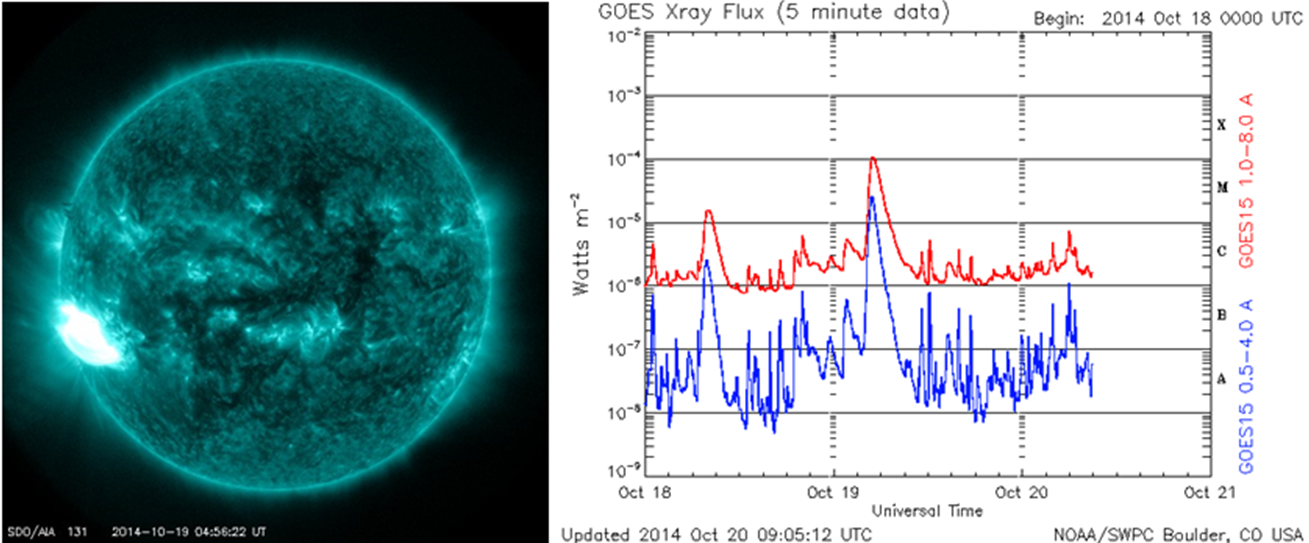
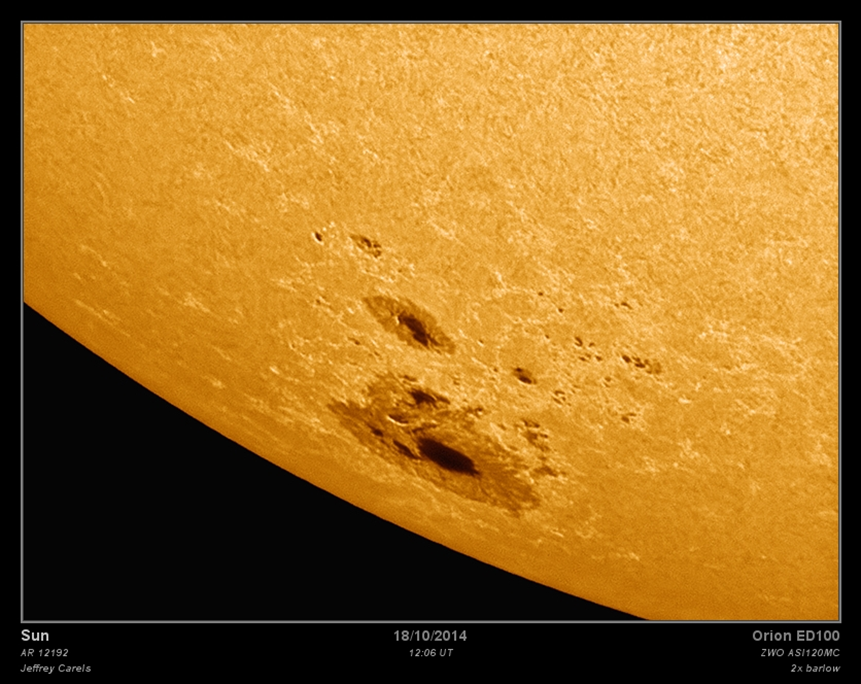
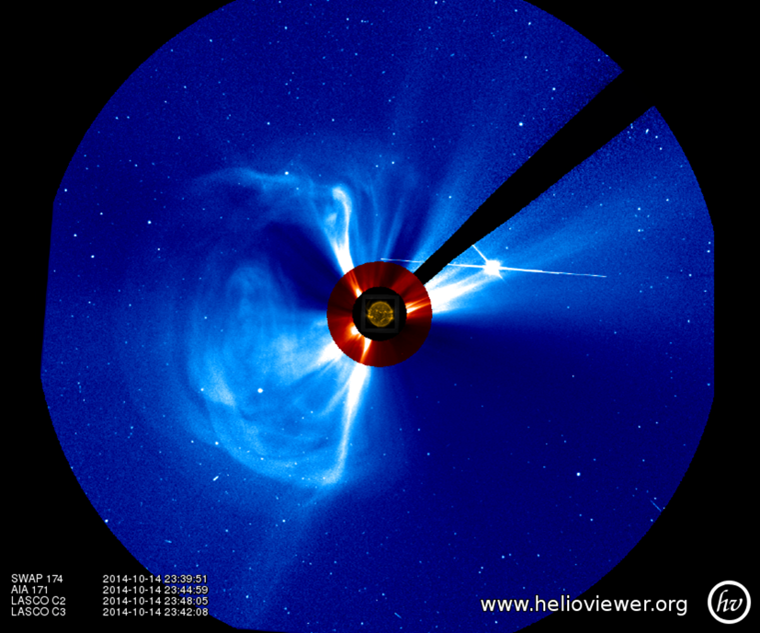
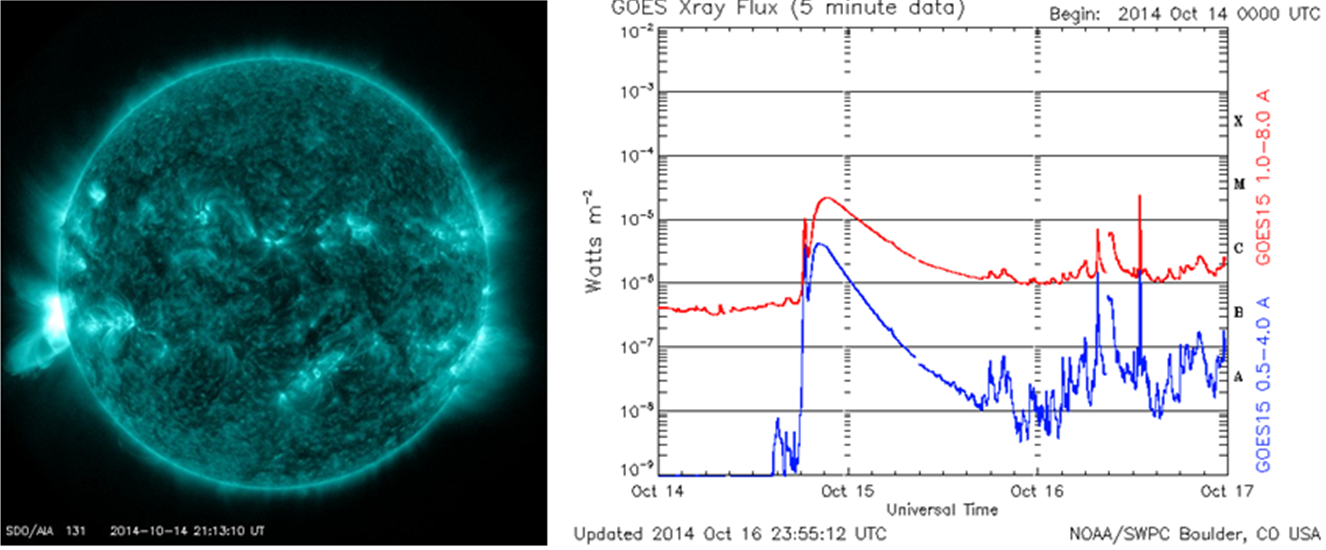
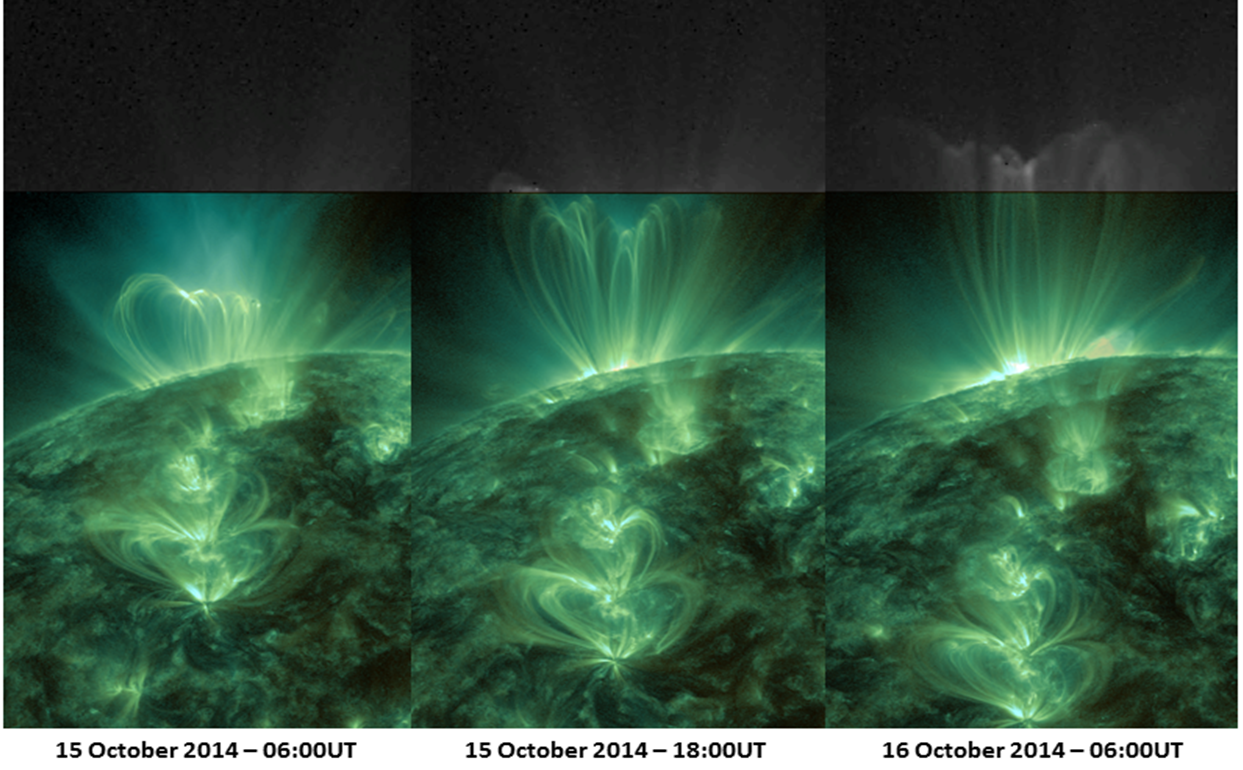

Credits - Imagery and data taken from SDO (http://sdo.gsfc.nasa.gov/), SOHO (http://sohowww.nascom.nasa.gov/home.html), PROBA2 http://proba2.oma.be/ssa), and STEREO (http://stereo.gsfc.nasa.gov/).
Disturbing news from the STEREO Science Center:
"Communications with the STEREO Behind spacecraft were interrupted on October 1, immediately after a planned reset of the spacecraft performed as part of a test of solar conjunction operations. The cause of the anomaly is not yet known, though a sensor anomaly in the guidance and control system is suspected. Attempts to recover the spacecraft are continuing."
This does not concern the anticipated degradation in communications as both STEREO spacecraft pass behind the Sun in 2014-2015, as discussed earlier in this news item at http://stce.be/news/253/welcome.html.
There really seems to be a technical problem with the spacecraft. The engineering team has met every day, and the original spacecraft designers have been consulted. With the aid of the Deep Space Network radio telescopes, the STEREO team is trying to re-establish contact with STEREO-B, but so far with no success. The communication efforts are obviously hampered by the Sun's proximity (line-of-sight).
"The question whether the current orbit of the STEREO-B spacecraft will carry it to a location where the signal strength will be stronger is difficult to answer, because the true attitude of the spacecraft is not known. However, assuming nominal Sun pointing, the signal strength will not improve until significantly past solar conjunction."
Gloomy perspectives, but hopefully the STEREO-team still manages to do the impossible! Fingers crossed!
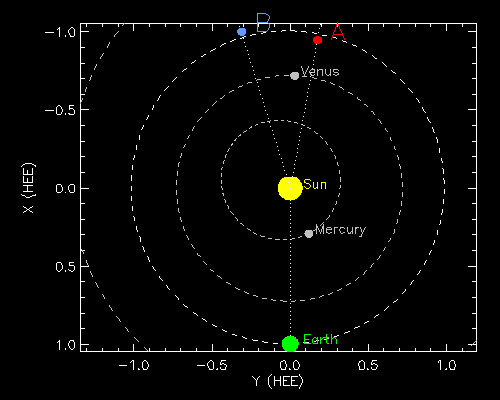
The week started without any C flares. On October 14, two M-flares from a region behind the east limb were registered. It was the active region that got the label NOAA 2192 once it rotated on the solar disk early October 17. The pictures below are taken with the USET (http://sidc.be/uset/ ) white-light CCD camera on three consequent days.
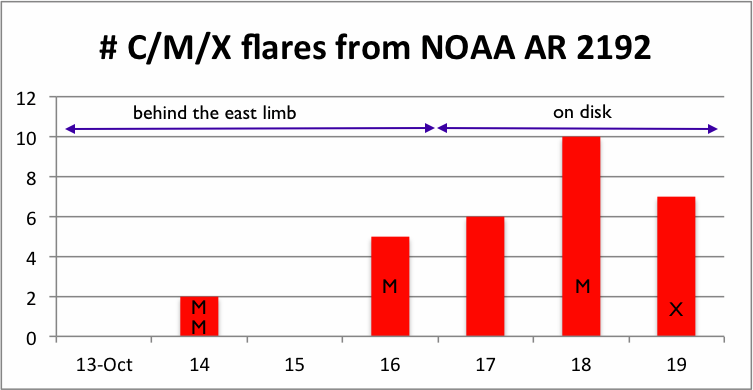
This beta-gamma region was the only region that produced flares above the B level. In total, 1 X flare, 4 M flares and 25 C flares were observed, all produced by AR 2192. So, it makes a rather simple flare-chart:
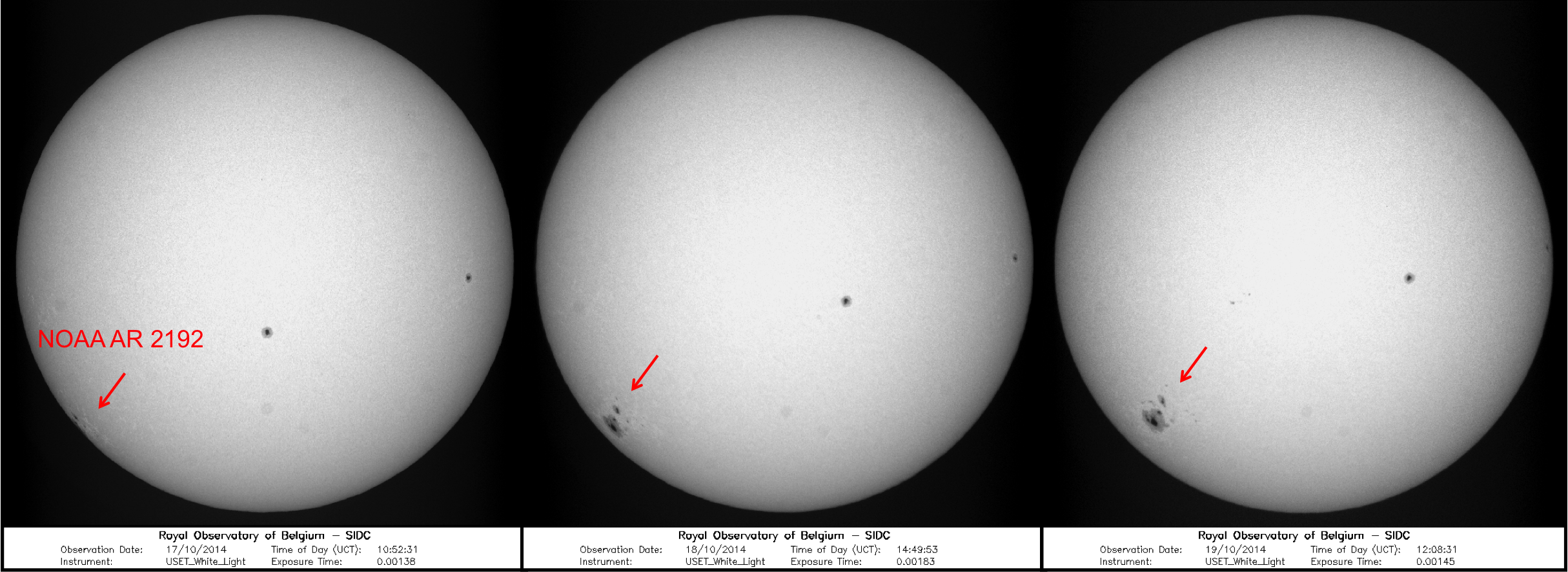
The M1.1 flare which peaked at 18:37 UT on October 14 was associated with a full halo (backside) CME first detected by LASCO C2 at 19:00 UT on October 14. Its main bulk propagated towards the southeast at an estimated speed of 923 km/s as measured on LASCO C2 and C3 imagery. Since it was backside, the CME was not geo-effective.
Solar wind speed as observed by ACE was variable and fluctuated between 300 and 520 km/s (hourly averaged).
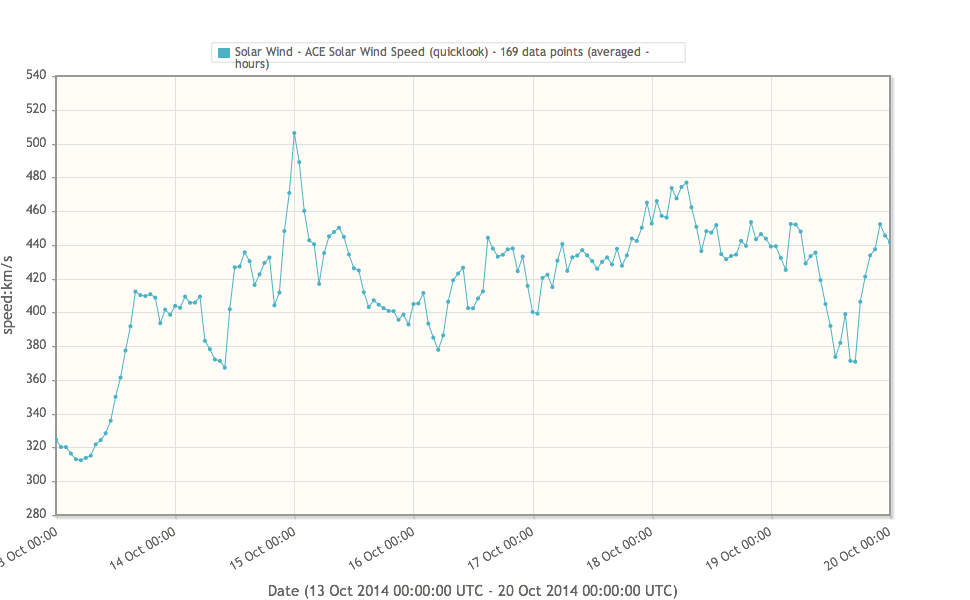
The magnitude of the Interplanetary Magnetic Field (IMF) varied between 0.5 and 16 nT.
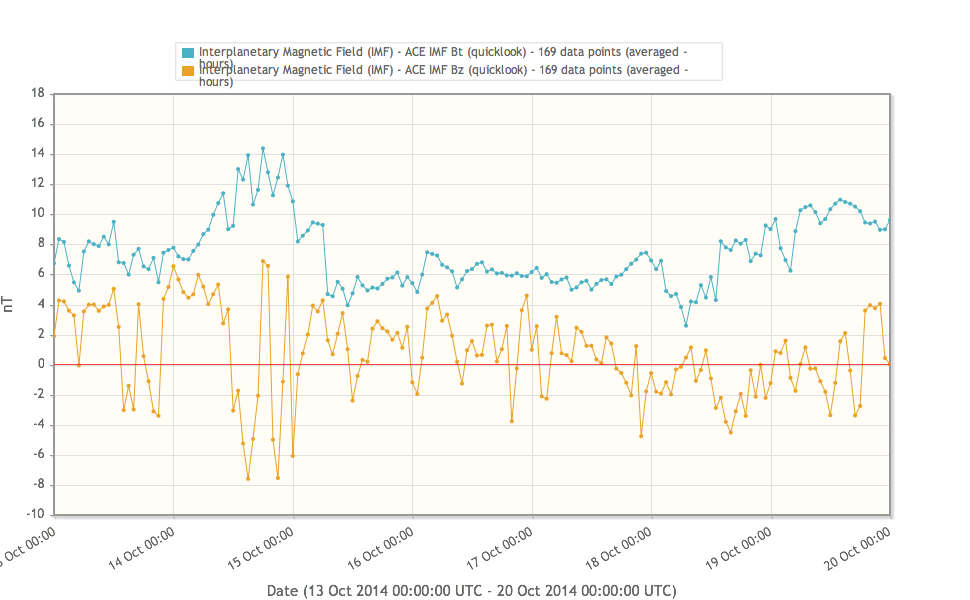
This variable behavior of the solar wind may be linked with the arrival of unidentified ICMEs. NOAA Kp indicated a minor geomagnetic storm between 18h UT on October 14 and 3h UT on October 15. On October 14, K Dourbes was above 3 from 17h till 21h UT and went to minor storm values between 20h and 21h UT. This was the result of the increased solar wind speed combined with Bz values below -10 nT or thereabouts. For the rest of the week, geomagnetic activity was quiet (K Dourbes and NOAA Kp smaller than 4), with some active (K Dourbes equal 4) excursions on October 17 to 19.
| DAY | BEGIN | MAX | END | LOC | XRAY | OP | 10CM | TYPE | Cat | NOAA |
| 14 | 1821 | 1837 | 1846 | M1.1 | 1300 | |||||
| 14 | 1907 | 2121 | 0019 | M2.2 | 180 | VI/1III/2CTM/1 | ||||
| 16 | 1258 | 1303 | 1305 | M4.3 | 190 | III/2 | 2192 | |||
| 18 | 0702 | 0758 | 0849 | S13E71 | M1.6 | SF | III/1 | 2192 | ||
| 19 | 0417 | 0503 | 0548 | X1.1 | CTM/1 | 2192 |
| LOC: approximate heliographic location | TYPE: radio burst type |
| XRAY: X-ray flare class | Cat: Catania sunspot group number |
| OP: optical flare class | NOAA: NOAA active region number |
| 10CM: peak 10 cm radio flux |
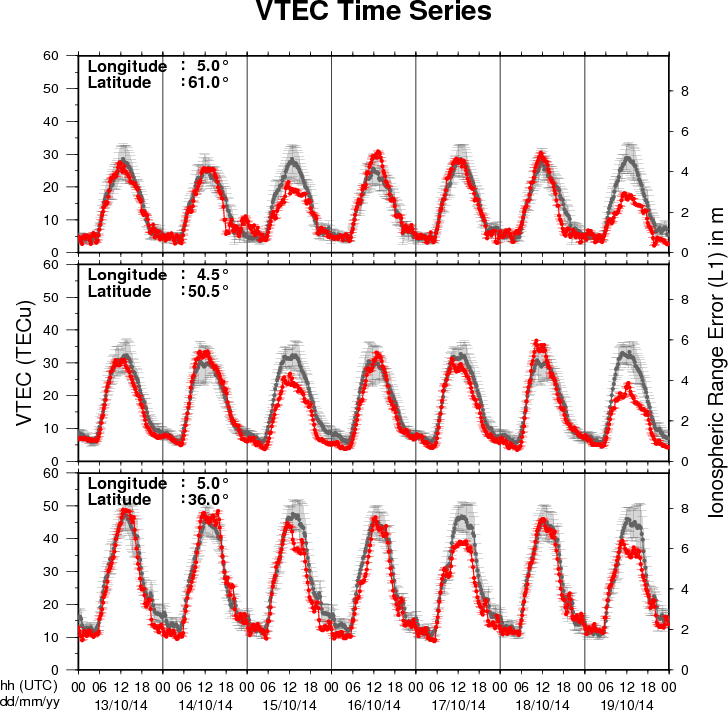
The figure shows the time evolution of the Vertical Total Electron Content (VTEC) (in red) during the last week at three locations:
a) in the northern part of Europe(N61°, 5°E)
b) above Brussels(N50.5°, 4.5°E)
c) in the southern part of Europe(N36°, 5°E)
This figure also shows (in grey) the normal ionospheric behaviour expected based on the median VTEC from the 15 previous days.
The VTEC is expressed in TECu (with TECu=10^16 electrons per square meter) and is directly related to the signal propagation delay due to the ionosphere (in figure: delay on GPS L1 frequency).
The Sun's radiation ionizes the Earth's upper atmosphere, the ionosphere, located from about 60km to 1000km above the Earth's surface.The ionization process in the ionosphere produces ions and free electrons. These electrons perturb the propagation of the GNSS (Global Navigation Satellite System) signals by inducing a so-called ionospheric delay.
See http://stce.be/newsletter/GNSS_final.pdf for some more explanations ; for detailed information, see http://gnss.be/ionosphere_tutorial.php
Start : 2014-11-12
This conference aims to bring together researchers, engineers,
users in the area of Big Data in the Space sector.
The focus is on the whole data lifecycle, ranging from data
acquisition by spaceborne and ground-based sensors to data
management, analysis and exploitation in the domains of Earth
Observation, Space Science, Space Engineering, Space Weather,
etc.
Special emphasis will be put on highlighting synergies and
cross-fertilization opportunities from domains like Climate Change,
Solid Earth Science, Planetary Sciences, Life Science,
Astrophysics, High Energy Physics, Social Sciences, etc.
We expect this conference to:
* contribute towards a common "Big Data from Space" scientific
and programmatic framework
* widen competences and expertise of universities, labs and
industrial actors
* foster networking of experts and users towards better access
and sharing of data, tools and resources
* leverage innovation, spin-in, spin off of technologies, and
business development arising from research and industry
progress
Website:
http://congrexprojects.com/2014-events/BigDatafromSpace/objectives
Start : 2014-11-17 - End : 2014-11-21
The 11th Edition of the European Space Weather Week will take
place on 17-21nd November 2014 in Liège, Belgium.
The ESWW will again adopt the central aim of bringing together
the diverse groups in Europe working on different aspects of Space
Weather. This includes but isn't limited to the scientific
community, the engineering community, applications developers,
service providers and service end users.
The meeting organisation is coordinated by the Belgian
Solar-Terrestrial Centre of Excellence (STCE), ESA and the Space
Weather Working Team. The local organisation is done by the
STCE.
Website:
http://www.stce.be/esww11/
Start : 2014-12-15 - End : 2014-12-19
The AGU Fall Meeting is the largest worldwide conference in the
geophysical sciences, attracting more than 22,000 Earth and space
scientists, educators, students, and other leaders. For 46 years,
energized and passionate Earth and space scientists from around the
world gather at the AGU Fall Meeting to connect with colleagues,
broaden their knowledge base, and embrace the joy of science. The
2014 meeting takes place Monday 15 - Friday 19 December 2014.
Several sessions about space weather are foreseen:
*
When and Why Does Space weather Forecasting Fail?
*
Addressing Operational Space Weather Needs
*
Near Real Time Data for Earth Science and Space Weather
Applications
*
Understanding Hemispheric Asymmetry and Space Weather
*
Connection of Solar Events With the Variability of Space
Environments
*
Bz from the Sun to the Earth: Observations and Modeling
*
Solar Sources and Heliospheric Consequences of Coronal Mass
Ejections in Solar Cycle 24
*
Advances in Ionospheric Forecasting - Modeling, Observations, and
Validation
Abstract Submission Deadline: August 6, 2014
Website:
http://fallmeeting.agu.org/2014/
Start : 2015-04-20 - End : 2015-04-24
This gathering was born out of the desire to collect in one
place the latest technologies required for advancement of science
in the discipline of Solar and Space Physics. In doing so, it was
recognized that the two 1998 volumes of 'Measurement Techniques in
Space Plasmas' (Particles and Fields) have been a valuable
reference and resource for advanced students and scientists who
wish to know the fundamentals of measurement techniques and
technology.
Website:
https://mtssp.msfc.nasa.gov/
Start : 2015-06-22 - End : 2015-07-02
We invite contributions on novel inversion methods with
application across the geosciences. Of particular interest are 3D
imaging, joint inversion of geodetic, geophysical and geochemical
datasets, and multi-disciplinary interpretation approaches such as
integration of gravity, EM and seismic data or thermo-mechanical
modelling studies constrained by physical parameters.
Modelling of Space Weather Effects: Solar, Magnetospheric and
Earth Resistivity Constraints (IAGA, IAMAS)
In this symposium we welcome contributions on all aspects of the
modelling of space weather and its effects, from the Sun to Earth.
This includes the modelling of the various interactions between
travelling solar storms and the solar wind, magnetosphere,
ionosphere and solid Earth and the validation of models through
measurements. Contributions on models developed to aid end-users,
such as satellite and power grid operators, survive the impact of
space weather are also encouraged.
Website:
http://www.iugg2015prague.com/joint-inter-association-symposia.htm#JA
Presentation, in French given at the open doors of the Space Pole, Brussels, Belgium, 2014
http://www.spaceweather.eu/en/repository/show?id=542
Presentation, in Dutch given at the open doors of the Space Pole, Brussels, Belgium, 2013.
http://www.spaceweather.eu/en/repository/show?id=543
Presentation, in French given at the open doors of the Space Pole, Brussels, Belgium, 2014
http://www.spaceweather.eu/en/repository/show?id=544
Presentation, in French given at the open doors of the Space Pole, Brussels, Belgium, 2014
http://www.spaceweather.eu/en/repository/show?id=545
Presentation, in French given at the open doors of the Space Pole, Brussels, Belgium, 2014
http://www.spaceweather.eu/en/repository/show?id=546
Presentation, in Dutch given at the open doors of the Space Pole, Brussels, Belgium, 2014
http://www.spaceweather.eu/en/repository/show?id=547
Presentation, in French given at the open doors of the Space Pole, Brussels, Belgium, 2014
http://www.spaceweather.eu/en/repository/show?id=549
Presentation, in Dutch given at the open doors of the Space Pole, Brussels, Belgium, 2014
http://www.spaceweather.eu/en/repository/show?id=548
Presentation, in Dutch given at the open doors of the Space Pole, Brussels, Belgium, 2014
http://www.spaceweather.eu/en/repository/show?id=550
Presentation, in Dutch, given at the open doors of the Space Pole, Belgium, 2014
http://www.spaceweather.eu/en/repository/show?id=551
Presentation, in Dutch, given at the open doors of the Space Pole, Belgium, 2014
http://www.spaceweather.eu/en/repository/show?id=552